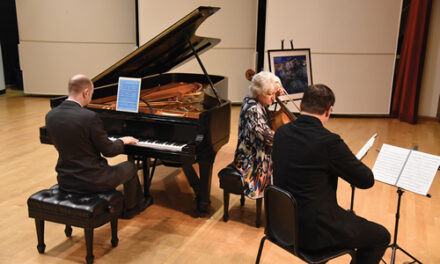The North Carolina Symphony performed in Meymandi Concert Hall on March 4 with guest conductor James DePreist and violinist Elmar Oliveira as the featured soloist. DePriest has served as Music Director of L’Orchestre Symphonique de Quebec, Sweden’s Malmö Symphony, L’Orchestre Philharmonique de Monte Carlo and the Oregon Symphony. The esteemed conductor has been awarded thirteen honorary doctorates and is highly sought as a guest conductor around the world. Oliveira brings with him a commitment to the entire spectrum of the violin world – a champion of contemporary music and rarely heard works of the past. He has received numerous honors and awards for his artistry as well as acclaim for his many recordings.
The concert opened with “Le Corsaire,” Op. 21, a concert overture by Hector Berlioz. Given the inspiration – a pirate and Lord Byron’s adventures in the Adriatic – it should be an exciting piece. It is not. Rather mundane, especially for Berlioz, it runs its uneventful course in less than ten minutes. What did impress me, however, was the style and class of this orchestra. Precision of ensemble, strings that sing as smooth as silk, balance among and within sections, and crisp articulation resulted in a beautifully finished product, even though the opening piece was nothing to get excited about.
Saint Saëns’s Violin Concerto No. 3 followed – another rather bland programming choice in our estimation. The program notes on this work begin “There has probably never been an entirely complimentary evaluation written of Camille Saint-Saëns.” And further down, a review following the American premiere of the Third Violin Concerto is quoted from the Boston Traveler: “Saint-Saëns is so completely a master of his musical material that whenever he has a musical idea he is thoroughly enjoyable. To be sure, he does not always have anything to say, and he has written a good deal of music without any apparent idea whatsoever.” When I think of works like The Carnival of the Animals, the “Organ” Symphony, the five piano concerti and even the nearly trivial Christmas Oratorio, I wonder how anyone could write such comments about this composer. To be fair, the Violin Concerto was not unsatisfying. After a rather dull first movement, the middle movement was delightful, wrapping itself around a tune that sounded like one of those charming lullabies of the Auvergne. The third movement hastened on to its conclusion with some very nice heroic moments. Oliveira delivered a flowing and heartfelt performance even if the music did not scale the heights of programmatic excitement. Here too the orchestra was superb, responding to subtle and obvious niceties in the score.
Serge Rachmaninov’s grand and rhapsodic Second Symphony filled the second half of the concert. The composer was not much for multi-tasking. He could concertize and his extraordinary pianistic skill mesmerized audiences wherever he went. He was an accomplished and effective conductor and was in great demand. And he had an undeniable touch of genius as a composer, especially in the creation of flowing lyrical melodies. But he could not do everything at once. So in 1906, with his wife and young daughter, he slipped quietly out of Moscow to a quiet little house in Dresden to give his attention to fleshing out the music he needed to write. Whereas Saint-Saëns reacted to the Wagner craze by seeking to go in the opposite direction, aiming for simplicity and formal precision avoiding romantic pathos and emotional ecstasy, Rachmaninov embraced these qualities. In fact, the reason for moving to Dresden was in part due to his memory of an entrancing performance of Die Meistersinger he had heard there a few years earlier. So the Second Symphony reflects some of the same nobility, majesty and life affirmation that the Hans Sachs tale embodies. Unlike the First Symphony, which had a disastrous premiere eleven years earlier, the Second was unanimously cheered and continues to be popular today as, possibly, the Mt. Everest of Romantic music. The first movement proceeds with ebb and flow through dark mystery and lofty peaks. The second movement marches boldly and confidently through life, undeterred by distractions that inevitable occur. The third movement is a love song of such rapturous proportions as to comparable to the second-act love duet in Tristan und Isolde. The final movement reflects back on the previous three and proceeds to dance and parade to a triumphant life-affirming conclusion. There is no program attached to this Symphony, and Rachmaninov never hinted at one, but if one were to subtitle it “A Paean to Life,” I don’t think it would be far off.
The last note must be one more accolade to the North Carolina Symphony, to its achievement to this point and to its potential for the future.











